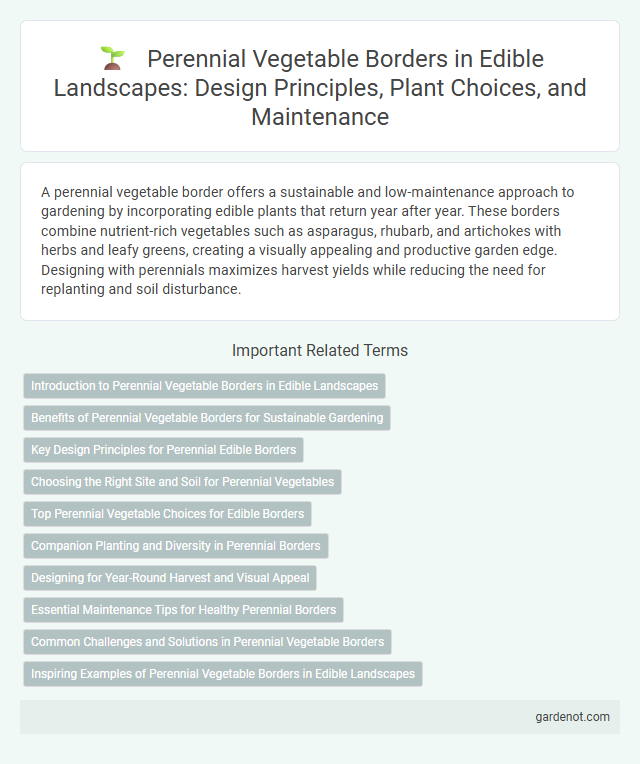A perennial vegetable border offers a sustainable and low-maintenance approach to gardening by incorporating edible plants that return year after year. These borders combine nutrient-rich vegetables such as asparagus, rhubarb, and artichokes with herbs and leafy greens, creating a visually appealing and productive garden edge. Designing with perennials maximizes harvest yields while reducing the need for replanting and soil disturbance.
Introduction to Perennial Vegetable Borders in Edible Landscapes
Perennial vegetable borders create sustainable and productive edges in edible landscapes by incorporating long-lasting plants such as asparagus, rhubarb, and sorrel. These borders require minimal maintenance while providing continual harvests across seasons, enhancing both aesthetics and food output. Integrating perennial vegetables optimizes garden space, supports biodiversity, and reduces soil disturbance compared to annual crops.
Benefits of Perennial Vegetable Borders for Sustainable Gardening
Perennial vegetable borders enhance sustainable gardening by providing year-round harvests with minimal soil disturbance, promoting soil health and reducing erosion. These borders support biodiversity by attracting beneficial insects and pollinators, contributing to a balanced ecosystem. Their deep-root systems improve water retention and nutrient cycling, decreasing the need for synthetic fertilizers and irrigation.
Key Design Principles for Perennial Edible Borders
Perennial vegetable borders enhance garden productivity by integrating edible plants that return year after year, optimizing space and reducing replanting efforts. Key design principles include selecting diverse species with varying heights and growth habits to maximize sunlight exposure and soil nutrients, while arranging plants to create natural windbreaks and microclimates. Emphasizing soil health through organic amendments and mulching supports long-term plant vigor and consistent harvests from the edible landscape.
Choosing the Right Site and Soil for Perennial Vegetables
Selecting the ideal site for a perennial vegetable border involves ensuring full sun exposure and well-drained soil with a pH between 6.0 and 7.0 to promote healthy root development. Soil rich in organic matter, such as compost or aged manure, enhances moisture retention and nutrient availability essential for perennial crops like asparagus, rhubarb, and artichokes. Proper site and soil preparation reduces weed competition and supports sustainable growth throughout multiple growing seasons.
Top Perennial Vegetable Choices for Edible Borders
Perennial vegetables such as asparagus, rhubarb, and perennial kale are top choices for edible borders due to their durability and high yield. These plants provide consistent harvests year after year, reducing the need for replanting and enhancing garden sustainability. Integrating perennial vegetables into landscape borders combines functional food production with aesthetic appeal, creating a productive and attractive edible landscape.
Companion Planting and Diversity in Perennial Borders
Perennial vegetable borders thrive through companion planting strategies that enhance growth, deter pests, and improve soil health by pairing complementary plants such as asparagus with chives or rhubarb with strawberries. Incorporating diverse species in these borders increases resilience against diseases and supports beneficial pollinators, creating a balanced ecosystem within the edible landscape. This diversity also extends harvest seasons and maximizes space efficiency, promoting sustainable gardening practices.
Designing for Year-Round Harvest and Visual Appeal
A perennial vegetable border integrates nutrient-rich crops like asparagus, rhubarb, and artichokes, providing continuous harvests throughout the seasons while enhancing garden aesthetics. Strategic layering and varied leaf textures create visual interest, ensuring the border remains vibrant and productive year-round. Incorporating companion plants boosts biodiversity, improves soil health, and sustains steady yields in the edible landscape.
Essential Maintenance Tips for Healthy Perennial Borders
Pruning perennial vegetable borders in early spring encourages vigorous growth and prevents overcrowding, ensuring each plant receives adequate sunlight and airflow. Regular soil testing and amending with organic matter maintain balanced nutrient levels essential for sustained productivity and soil health. Consistent mulching reduces weed competition, conserves moisture, and stabilizes soil temperature, promoting robust perennial growth year-round.
Common Challenges and Solutions in Perennial Vegetable Borders
Perennial vegetable borders often face challenges such as soil nutrient depletion, pest infestations, and competition from invasive weeds. Implementing crop rotation, organic mulching, and companion planting can improve soil health and reduce pest populations naturally. Regular monitoring and the use of resistant perennial varieties enhance long-term productivity and sustainability in edible landscapes.
Inspiring Examples of Perennial Vegetable Borders in Edible Landscapes
Perennial vegetable borders in edible landscapes showcase sustainable, low-maintenance gardening with diverse crops like asparagus, rhubarb, and artichokes that return each year. These borders maximize space and yield by combining nutrient-rich plants, such as perennial kale and sorrel, which provide continuous harvests while enhancing soil health. Examples highlight creative layering and companion planting techniques, promoting biodiversity, pest control, and year-round edible beauty.
Perennial vegetable border Infographic

 gardenot.com
gardenot.com